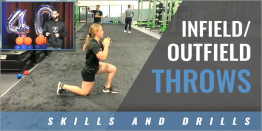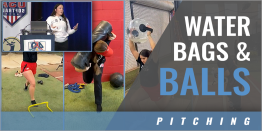|
By: Barb Kutch - Baseball and Softball Instructor Provided by: NFCA Throwing is as much rhythm and timing as hitting. The athlete is generating force from the ground and optimally transferring it into the ball. One disruption in timing can be disastrous. Like all rotational athletic movements, throwing follows the same kinematic sequence. The hips turn first, followed by the trunk, then the lead shoulder, and finally the ball. This facilitates the optimal transition of energy into the ball. As coaches, we have dozens of drills to promote the feel and sequence of a swing, but throwing drills seem hard to come by. Everyone's throwing goal is fast and accurate. Like hitting, "muscling up" or lazily flinging a throw will help an athlete find the bench instead of the target. For the kinematic sequence to fall into place, the body must move in a smooth continuous pattern. Any jerk or hesitation will derail the throw. Placing a strip of electrical tape around the circumference of a softball to provide immediate feedback on ball spin and tilt is known by most coaches. And it works well. A deviation to this is throwing a hockey puck. This is a drill baseball pitchers have been doing for years. The athlete holds the puck with a two-seam fastball grip so that the puck will make the same "straight line" as the electrical tape ball. The athlete works to throw the puck into a net with the perfect spin and tilt. Don't throw pucks to other people. Muscle up on the puck, and it will go nowhere; go lazy and it will flop through the air. Also, straight out of the world of baseball pitching, is the towel drill. The athlete holds a bunched-up portion of a hand towel in her throwing hand, leaving a good 1-2 feet of towel hanging. From here, she go through her throwing motion at full speed. A coach can put a tee in front of the athlete, roughly a little more than her height away. The goal can be for the athlete to whip the towel with the throwing motion to snap on top of the tee. Just like the hockey puck, muscling up on this will completely lock up the athlete, and the towel will not whip through. This drill can also be incorporated into small-space practice. For example, a catcher can work on full throw downs with the towel versus the ball, to refine the throwing sequence with her pop. To further develop rhythm and timing, the towel drill can also be progressed to a walking version, where players walk through the towel throws to reinforce foot placement and full body engagement. With older athletes, such as those in high school and college who are strong and have hands large enough, oversized softballs can help throwing mechanics. To throw a 14-inch softball, mechanics and sequencing need to be spot on. The ball will sail easily if the athlete is unable to stay on top throughout the throw. Players may need to be cued to complete their follow-through to prevent the ball from sailing. Like all throwing drills, it is imperative that the athlete resume throwing a 12-inch (or appropriate size) after the drill to facilitate the carryover to real throws. The simplest way to use baseball pitching drills with a softball player is to throw down a mound. While nowhere on a softball field is a mound, throwing off a mound can help an athlete feel the intense weight shift needed with throwing. The athlete will feel loading onto the back leg, then driving onto the lead leg. Balance problems will quickly be exposed due to the changing surface level. Upon landing down the mound, the athlete will need to brace through the lead leg to make an effective throw. Throwing off a mound can also reinforce the start of the throw with the lower body. Any asynchronous movement in the throw will significantly limit the velocity and/or accuracy of the throw. Coaches need to be mindful, though, that throwing off a mound may be more stressful for the shoulder and repetitions should be limited. Enough repetitions should be completed for the athlete to get the feel, then the skill needs to be transferred to game-like situations. If a player continues to struggle with the feel of an appropriate weight shift with throwing, throwing up the mound can also help this. As opposed to throwing down the mound, have the athlete stand behind the mound so that her lead foot lands uphill. This is not a drill to go full throttle on, but one meant to limit the weight shift to indirectly emphasize the weight shift with a flat-ground throw. After a few easy throws with this, have the athlete throw normally again. The athlete should feel more lower body involvement after the drill. |






